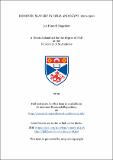Domestic slavery in Syria and Egypt, 1200-1500
Abstract
This study investigates domestic slavery in Syrian and Egyptian society from the thirteenth century to the fifteenth century. It focuses on the agency of slaves in the context of master-slave relationships within households and in wider society. It argues that the ability of slaves to shape the world around them was underpinned by a constant process of negotiation within the master-slave relationship and that intermediaries such as the court system channelled the agency of slaves. The principal sources for this study are purchase contracts, listening certificates, marriage contracts, and estate inventories in combination with scribal, market inspection, and slave purchase manuals as well as chronicles.
The structure of the study broadly follows the life cycle of slaves from importation to integration, accommodation, procreation, the possibility of manumission, and death. The first chapter investigates the topography and the commercial practices of slave markets, where owners chose slaves and initiated a deeply unequal personal bond which assigned a new function and identity to newly imported slaves. The second chapter provides two case studies based on manuscript collections in order to historicize and problematize the patterns set out previously. The third chapter studies the social integration of slaves and freed slaves on the basis of listening certificates. It argues that the slave population consisted mainly of imported Ethiopian and Turkish slaves who were highly integrated into urban society. The fourth chapter discusses the sexual dimension of domestic slavery by focusing on concubinage, marriage, and slave procreation. It brings together a range of documentary and legal sources to provide case studies of strategies of accommodation and resistance. The fifth chapter investigates manumission and its impact on the household dynamics of slavery. The sixth and final chapter analyses a collection of estate inventories of freed slaves and discusses the continuity of master-slave relations after manumission.
Type
Thesis, PhD Doctor of Philosophy
Items in the St Andrews Research Repository are protected by copyright, with all rights reserved, unless otherwise indicated.
Related items
Showing items related by title, author, creator and subject.
-
‘Medic!’ An insight into Scottish field surgeons, physicians, and medical provision during the Thirty Years’ War, 1618-1648
Murdoch, Steve (2017-08-30) - Journal articleThis article investigates the provision of medical care for Scottish soldiers engaged in the Thirty Years' War. It is based on archival research in Scotland, England, Denmark, Sweden and the Netherlands. It shows that ... -
Neutral före neutraliteten : svensk sjöfart i krigens skugga, cirka 1650–1800
Murdoch, Steve; Müller, Leos (Makadam förlag, 2017-06-01) - Book itemThis chapter reviews the strategy of neutrality developed by Sweden during times of war between the great European powers. Although the later league of armed neutrality of the 18th century is well known, this chapter ... -
Public botanic gardens and the early institutionalisation of science : Edinburgh, Florence, and Pisa in the second half of the eighteenth century
Romero-Passerin d'Entreves, Elena (University of St Andrews, 2022-06-16) - ThesisThis thesis is a comparative study of four botanic gardens in Scotland and Tuscany in the second half of the eighteenth century. Taking an approach based on case studies, it argues that botanic gardens were early examples ...

